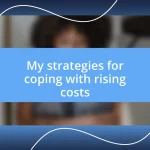Key takeaways:
- The storytelling revival emphasizes authenticity and emotional resonance, fostering genuine connections amidst digital noise.
- Effective storytelling techniques include pacing, dialogue, and visualization, which enhance audience engagement and create memorable experiences.
- Exploration of diverse storytelling mediums and the importance of community enrich narratives, highlighting the shared human experience through various forms of expression.

Understanding storytelling revival
The storytelling revival, to me, feels like a warm embrace of creativity in a world that often prizes speed over substance. I remember sitting in a cozy café, sipping on my coffee, when I overheard a group recounting old family stories—haunting yet laughter-inducing tales that wove generations together. Have you ever felt that connection through words, where a story made you acutely aware of your own experiences?
As I delved deeper into this revival, I noticed how it intertwines with our desire for authenticity. In an age of digital noise, people seem hungry for genuine connection, and stories often serve as a bridge. Personally, it breaks my heart to witness some people lose the art of narrative, as I’ve found it to be a powerful tool for expressing emotions that words alone often fail to capture.
One of the fascinating aspects of this revival is its communal nature. I find it incredible how storytelling circles have emerged, where people gather to share their narratives and learn from one another. Isn’t it remarkable how a simple story can evoke empathy and understanding? For me, these exchanges have turned strangers into friends, reminding me just how potent storytelling can be.

Key elements of modern storytelling
Modern storytelling thrives on authenticity and relatability. I’ve found that these elements resonate deeply with audiences today. It’s fascinating how a well-told story can create a space where listeners reflect on their own lives, fostering connections that transcend superficial interactions. For instance, at a recent storytelling event I attended, a woman shared her struggles with anxiety. Her vulnerability transformed the room; you could feel everyone leaning in, as if her words were inviting them to face their own fears.
Here are some of the key elements I’ve identified in modern storytelling that truly make a difference:
- Authenticity: In an era filled with curated images and crafted personas, genuine stories stand out.
- Emotional Resonance: Great stories evoke emotions, allowing the audience to connect on a deeper level.
- Interactivity: Involving the audience in the storytelling process creates a collaborative atmosphere, enhancing engagement.
- Diversity of Perspectives: Embracing varied voices enriches narratives, fostering understanding across different cultures and experiences.
- Visual and Sensory Elements: Including multimedia components or vivid descriptions helps paint a picture that captivates the audience.
I vividly recall a young spoken word artist who entranced the crowd with a poem about her upbringing. Her imagery was so powerful that I could almost smell the street food she described. That kind of immersive storytelling, where you’re drawn in and feel part of the experience, is what I believe defines modern narratives.

Techniques for effective storytelling
I’ve noticed that pacing is crucial in effective storytelling. It’s all about knowing when to build tension and when to release it. For instance, in a storytelling workshop I attended, a seasoned storyteller demonstrated this beautifully. He paused dramatically right before revealing a key plot twist, leaving us all hanging on his every word. That moment taught me how pacing can heighten anticipation and engage the audience deeply.
Another technique that stands out to me is the use of dialogue. When characters speak, it gives life to the story. I remember hearing a tale where the dialogue was so vivid that I could picture each character’s mannerisms, their unique voices almost echoing in my mind. It made the story not just something I listened to, but something I experienced intimately. Dialogue can create intimacy, allowing us to connect with characters on a personal level.
Visualization is another powerful tool I’ve come to appreciate. By painting mental pictures, stories can transport us to different places and times. At one event, a storyteller described a bustling market, complete with rich aromas and vibrant colors. I could almost feel the sun on my skin. Visualization creates a sensory experience that makes storytelling memorable.
| Technique | Description |
|---|---|
| Pacing | Knowing when to build tension and when to release it to engage the audience. |
| Dialogue | Bringing characters to life through their spoken words, creating intimacy with the listeners. |
| Visualization | Using vivid descriptions to transport the audience into the setting and evoke sensory experiences. |

Exploring diverse storytelling mediums
Exploring different storytelling mediums has truly expanded my understanding of narrative art. Whether it’s film, podcasts, or graphic novels, each medium offers a unique lens through which to convey a story. Recently, I found myself utterly captivated by a podcast series that utilized ambient sounds to enhance emotional depth. It made me wonder—how often do we overlook the power of sound in storytelling? That immersive audio experience drew me in, making the narrative feel almost tangible.
I’ve also had my share of moments with visual storytelling, especially through graphic novels. The combination of images and text works in harmony to elicit emotions in ways that words alone sometimes can’t. I recall being moved by a poignant comic that depicted loss through minimalistic art; it revealed the raw grief of its characters in just a few frames. Isn’t it interesting how a sequence of images can hit you where words might fall short? This intersection of visual and textual storytelling creates a unique dialogue with the audience.
As I’ve engaged with various storytelling forms, I’ve come to appreciate the community aspect they foster. During a local storytelling festival, I saw how different mediums attracted diverse crowds—all drawn together by a shared love for stories. From spoken word performances to short films, each audience member engaged differently, yet there was a collective energy in the air. How does that sense of community enrich our experiences? Personally, I believe it amplifies the stories told, creating a mosaic of narratives that reflect our varied lives.

Analyzing impactful storytelling examples
Analyzing impactful storytelling examples really highlights the nuances that make a tale resonate. I recall watching a powerful short film that followed a young girl’s journey through grief. The silent moments were just as intense as the dialogue, allowing the audience to feel her sorrow intimately. It raised the question for me: how often do we neglect the potency of silence in storytelling? That film genuinely showed me that sometimes, what isn’t said speaks louder than words.
Take, for instance, a beautifully crafted memoir I read last year. The author’s use of vivid memories turned mundane details into compelling narratives. I found myself nodding along, recognizing fragments of my own life in her experiences. It made me think—how can personal stories bridge connections among strangers? This memoir reminded me that relatability is often the bedrock of impactful storytelling. It drives home the idea that our shared experiences can create bonds even in vastly different lives.
Then there’s the power of humor, which was embodied in a stand-up routine I attended. The comedian expertly weaved personal anecdotes with societal observations, creating an engaging commentary on everyday life. I felt the room shift as laughter turned into reflection. Could it be that humor serves as a gateway to deeper truths? This experience illuminated how effective storytelling often combines light and heavy elements, inviting us to explore serious topics with a more open heart.

Building your storytelling skills
Building storytelling skills is really about practice and experimentation. I remember the first time I stood up to share a story at a local open mic night. My heart raced, and I felt utterly exposed. But as I spoke, I noticed how storytelling can transform fear into connection. Each laugh and gasp from the audience fueled my confidence. Have you ever experienced that electric moment when a story resonates with someone else?
One of the most enjoyable aspects of growing as a storyteller is the incredible variety of techniques you can play with. I started incorporating sensory details into my narratives, which felt like magic. For instance, when describing a childhood summer, I didn’t just say it was hot; I evoked the scent of fresh-cut grass and the taste of icy lemonade. It pulled listeners right into the moment. Isn’t it fascinating how a few descriptive words can evoke a vivid scene in someone’s mind?
Finally, don’t underestimate the role of feedback in honing your craft. I cherish the critiques I’ve received from fellow storytellers after sharing my pieces. Their insights often highlight strengths I wasn’t aware of, as well as areas for improvement I couldn’t see. I recall one specific instance where a buddy suggested I focus more on emotional authenticity. That small adjustment made my subsequent stories much more relatable. How do you incorporate feedback into your storytelling process? I’ve found that embracing constructive criticism can be a game-changer.














